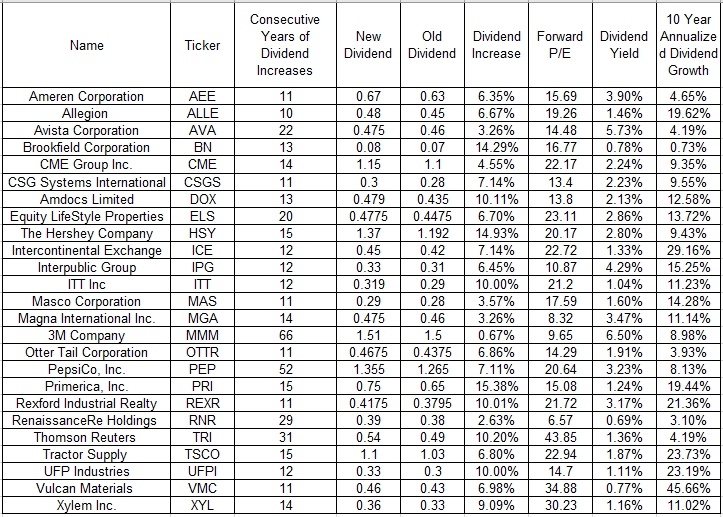There were 68 dividend increases in the past week. It looks like corporate boards are flush with cash, and consumer confidence is slowly rising. There is a record low unemployment, and the consumer is spending again, which is good for corporate revenues and bottom lines.
When companies raise dividends, they signal their confidence in the near term prospects of the business. A dividend is a sacred cow in the US. This is why business leaders need to evaluate the cashflow estimates over the next couple of years against estimated cash outflows and growth plans for future investment. Only after a reasonable amount of cashflow is left over, which is more than what the business needs, can they decide what the dividend rate should be. If a business expects to grow excess cashflows over time, they will most likely return a growing amount of cashflows to its shareholders.
Our goal is to evaluate each business, its prospects, fundamentals and valuation, before considering it for our portfolios.
Out of the list of 60+ dividend increases, I focused on the companies that have increase dividends for at least ten years in a row. There were 25 companies that raised dividends last week, which also have at least a ten year streak of annual dividend increases. Two of those companies were dividend kings, having increased dividends for over 50 years in a row. Three of these companies are dividend champions, having increased dividends for over 25 years in a row. The rest were either dividend achievers, or newly minted dividend achievers.
I then consolidated the information in a tabular format, for easier review:
The next step in the process would be to review trends in earnings per share, in order to determine if the dividend growth is on strong ground. Rising earnings per share provide the fuel behind future dividend increases.
This should be followed by reviewing the trends in dividend payout ratios, in order to check the health of dividend payments. A rising payout ratio over time shows that future dividend growth may be in jeopardy. There is a natural limit to dividends increasing if earnings are stagnant or if dividends grow faster than earnings.
Obtaining an understanding behind the company’s business is helpful, in order to determine how defensible the dividend will be during the next recession. Certain companies are more immune to any downside, while others follow very closely the rise and fall in the economic cycle.
Of course, valuation is important, but it is more art than science. P/E ratios are not created equal. A stock with a P/E of 10 may turn out to be more expensive than a stock with a P/E of 30, if the latter is growing earnings and the former isn’t. Plus, the low P/E stock may be in a cyclical industry whose earnings will decline during the next recession, increasing the odds of a dividend cut. The high P/E company may be in an industry where earnings are somewhat recession resistant, which means that the likelihood of dividend cuts during the next recession is lower.
Relevant Articles:
- Not all P/E ratios are created equal
- My Entry Criteria for Dividend Stocks
- Dividend Growth Investing Gets No Respect
- Why the best investment plans never turn out as expected

